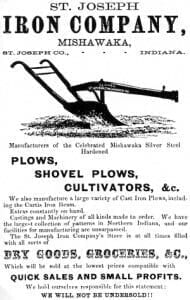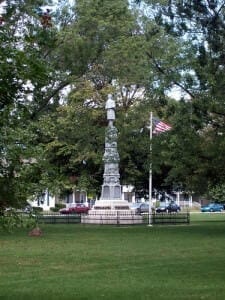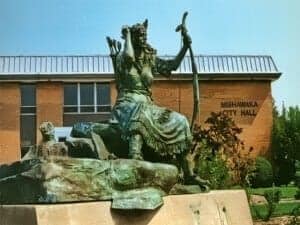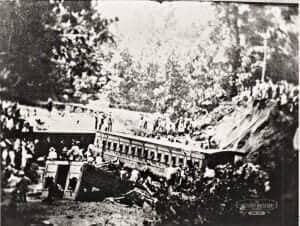History of Mishawaka, Indiana
St. Joseph Iron Works Company
In 1832, a prospector named William Earl was sent to the Mishawaka area by a Detroit businessman, Alanson M. Hurd. Mr. Earl was to check the south bank of the St. Joseph River along the rapids where Mishawaka would later be founded. He found a deposit of bog iron [rock-like geologic deposits containing a very small amount of crude iron] and followed it to the swampy and wet areas south of the river and found that this land, also, contained large deposits of bog iron.

Alanson Hurd bought and shipped building supplies for his factory from Detroit and shipped them to St. Joseph, Michigan, and then shipped them up the St. Joseph River on keel boats to the site of his blast furnace. Mr. Earl and Elias Smith brought a large group of men (some records say 100 men) from Detroit to the blast furnace to work.2 As soon as the men arrived they began building the blast furnace which would go on to be the very first blast furnace in Indiana. The factory was named the St. Joseph Iron Works and the men that lived around the factory called their little village (also) St. Joseph Iron Works. This was the name of the town before it was permanently changed to Mishawaka.
During this period in Mishawaka’s history, everything revolved around the St. Joseph Iron Works. Earl Smith opened a tavern and small boarding house for several of the factories workers. The company also opened a small store called the A.M. Hurd and Company.
A.V. Yerrington was a bookkeeper and clerk for Alanson Hurd who eventually became the postmaster of the small village. Mr. Yerrington petitioned the government to permanently name the small village Mishawaka and officially name the post office the same name. The Indiana Legislature officially ‘set’ the name on December 11, 1833. One year later the first post office, named Mishawaka, was built.
The St. Joseph Iron Works began to make castings for stoves, plows, cooking utensils, mill gears, and shipped pig iron to Detroit.
Indiana City
Another interesting development in the settlement of Mishawaka was 
At the end of 1837 there was no less than 4 independent ‘towns’ within a sizable area around the St. Joseph Iron Works. On February 17, 1838, an act of the state legislature was approved to combine these four towns. The act read:
That the name of the town of St. Joseph Iron Works and the name of the town of Indiana City, in St. Joseph county, be, and the same are hereby changed to that of Mishawaka; and that all the lots now laid out on either side of the Big St. Joseph River, whether included with the towns of St. Joseph Iron Works, Indiana City, Mishawaka, or additions thereto, be included with the incorporation of the town of St. Joseph Iron Works (hereafter to be known by the name Mishawaka).
The Naming of Mishawaka

On January 21, 1835, Mishawaka became the first town to be incorporated, preceding by a few months the platting of the town of South Bend.
South of the newly named town of Mishawaka was a section several miles wide which was covered with water most of the year. The marsh made roads into Mishawaka from the south impassable most of the year. South of the marsh was a place called the Thick Woods. Lumbermen and farmers inhabited this part of St. Joseph County.
Up until the 1830s people who wanted to cross the St. Joseph River used canoes, boats, or forded the river at Twin Branches or near the rapids. Construction on a dam began in 1833 above the north and south races to increase the amount, and speed, of water that could be used for power. Building of this dam wasn’t completed until 1837.
The first known bridge across the St. Joseph River was built in 1836. Mr. Tuttle gave the land next to the St. Joseph Iron Works Company for a street to be built to the bridge. The street was named Bridge Street for obvious reasons. A Mr. DeCamp from Elkhart, Indiana was hired to build the bridge. The lumber for the building of the bridge was floated downriver from Elkhart to the building site in Mishawaka. The bridge was known as the “Bent Bridge” because it was higher in the middle than on the ends.
When the bridge first opened a toll was collected to cross the bridge. Persons go to and from church were allowed to cross for free. U.S. military troops, state militia, and military supplies could also cross the bridge for free. However, the bridge eventually became toll-free.
The bridge stood for 9 years until ice destroyed the northern part of the bridge. A covered bridge was built in 1848 to take its place. After it was built it was painted bright red and was a spooky place at night. To fight the darkness, Horace B. Fitch was paid $3.00 a month to line the inside the bridge with candles and to keep them lit throughout the night.
In the fall of 1839, George C. Merrifield opened a school in a building at the corner of Union and Fourth Street. He had taught school before coming to Mishawaka in 1837. On October 5, 1851, Mr. Merrifield dismissed all his students early to attend a town celebration welcoming the first passenger train to arrive in the small village. The Michigan Southern and Northern Indiana Railroad train had chugged into Mishawaka for the very first time. The steam train locomotive was named the John Striker and was about the size of a small farm tractor. It burned wood for fuel, had to be stopped by using hand brakes, and had 3 passenger cars and a baggage car. Thirty-five passengers were aboard the train.
The first freight train through Mishawaka was named “Goshen.”
There were many industrious craftsmen now settled in Mishawaka and many industries were established. Mishawaka-manufactured items were being shipped by keel boat, wagon, and now the railroad. These items went all over the United States and people were drawn to Mishawaka because of the fame of things made there. This immigration to Mishawaka were led by many who came from Belgium and Italy. They brought with them their families, their social cultures, their food, the religious beliefs, and a new cosmopolitan atmosphere to the town of Mishawaka.
The Terrible 1859 Railroad Disaster
A little before midnight on June 27, 1859 the Night Express train traveling from Chicago to Toledo roared into South Bend. It had been a very rainy couple of days when the Michigan Southern train carrying 150 people reached the Springbrook Bridge and the ravine it covered. The soil holding up the railroad bridge was loosened to such an extent that when the train reached the ravine, the bridge gave way and the train, and all its cars careened into the flooded abyss.

About 150 people were on the train; 60 were immediately taken from the wreck already deceased, and 50 or 60 more were wounded, or escaped unhurt. Many were not found until days later and they all had drowned and their bodies were carried downstream. Citizens of South Bend and Mishawaka were alerted to the accident by church bells being rung in the middle of the night and many groups of people showed up at the accident to help with the wounded.
A man who’s family had traveled on the doomed train recounted his experience:
The scene of the banks of the ravine [Mr. Pardee says] was truly awful, as one may well suppose, but he says the amount of human misery among the wounded was terrible to behold. In the Mishawaka hotel he saw a fine little boy about 9 years old, with his left leg broken, and almost open through the thigh, while the right let is cut completely off. The lad was failing fast and it is almost impossible for him to recover.
He was one of a family of five children, with the mother, who were going to meet the father and the husband of this family. The mother was killed, a daughter is missing, and another boy is wounded not seriously. He is in the same room with his wretched brother, while he saw another of the young ones, six years old, dead, having had his face completely cut off. The bodies of the women were not much mutilated.
Another passenger, J.J.H. Rice, on the train recounted his experience:
He was in the sleeping car at the time of the accident, which occurred about midnight. The first he knew of anything being the matter was when the water was rushing over the cars. The lights were out, and nothing but an occasional flash of lightning was there to see by. He jumped from the cars, but instead of landing on terra firma, he leaped into the torrent of water, but succeeded in making his way to a clump of bushes and got up the bank afterward. He heard a great deal of screaming while in the current, and after landing the cries of distress were awful. There being no lights, everything was in confusion, and survivors were rushing madly about the banks of the ravine in vain search of their missing friends and family. He says one was killed in the sleeping car, but one old gentleman jumped out and was drowned in the current. Mr. Rice says Osgood [the conductor] seemed crazy, he ran to South Bend and to Mishawaka, and then returned a distance of 8 miles, without his hat. He took charge of him and brought him to the city [Davenport, Iowa] at 3:30 p.m. yesterday.
One woman who was on the train with her husband and five children, ran wildly about all night seeking her family, but without success, until morning, when she found them all dead. She then went to a farm house a few yards off, where after sitting some minutes, the wretched wife and mother expired.
Mr. Rice says that a gentleman, with his wife and two children, were on the train on a pleasure trip to the East. But in the accident the parties became separated. The husband found one of his young ones dead in the morning; next he found his wife dead, but with her arms closely embracing the other child, who was saved.
The politically famous South Bend resident Schuyler Colfax sent a note to the Davenport Daily Gazette in Davenport, Iowa, on July 4, 1859 and explained that three more bodies had been found.
Hon. Schuyler Colfax informs us under date of Friday evening, in a note written in the cars, that two bodies were taken out of the ravine where the accident occurred, Thursday afternoon. They were completely buried in the sand. The first one was discovered by the toe of his foot being noticed. One of these persons is named Campbell; the other is not known.
This morning the body of Miss Regan was found in the St. Joseph River, less than a mile below the fatal creek ravine. She was identified by Mr. Whinery of South Bend (at whose house her mother died) by her dress.
Pieces of clothing have been found today by the workmen at the wreck, but up to 3:00 p.m., no more bodies [have been found].
Before the work of rebuilding the culvert is commenced, the people of Mishawaka have determined on excavating the ground, to see if more bodies cannot be found. This course was determined upon a public meeting held in that place on Wednesday evening.
Today, the area close to the intersection of Ironwood and Lincoln Way East is where this accident happened. The unclaimed bodies were eventually buried in Mishawaka’s City Cemetery. Eventually all but a few of the victims of the disaster were claimed, the bodies not claimed still reside within Mishawaka City Cemetery in a mass grave.
The End of Bog Iron Deposits
In 1856, there were no more bog iron deposits in the swamps. The Saint Joseph Iron Works changed to manufacturing. In 1868, the name was changed to the St. Joseph Manufacturing Company. For 35 years the company made plows, cultivators, farm equipment and other machinery.
In 1903, the name was changed again to the Mishawaka Plow Company. The company made the first railroad hand car and it was tried out on the local tracks running through Mishawaka.
John Wagner, a German who had immigrated to Detroit, heard of the wonderful opportunities available in a small village called Mishawaka. He traveled and settled in the town in 1839 and started a brewery and distillery. The corn whiskey made was sold for $25 a gallon. The building burned to the ground on October 30, 1851. Mr. Wagner had bought land west of the town and started over again. The brewery was sold several times.
By 1887, Kamm and Schellinger Brewing Company was incorporated in that same building. A dam was built from the shore behind the building to an island in the river. In the winter, ice was cut from here and stored in the basement. In 1889, the company installed an ice-making machine that could make a ton of ice per hour.
Kamm and Schellinger beers became famous. The company switched to making soft drinks during Prohibition, but went back to brewing beer after Prohibition ended.
During the Civil War, Mishawaka supported Abraham Lincoln and the Federal Union. Many local men volunteered in the 9th, 48th, or 87th Indiana regiments. The citizens at home supported the war effort and made many sacrifices. They helped the poor, and the soldiers’ families left here. Factories and farms from the local area supplied materials and food for northern armies.
Wallace H. and William W. Dodge, brothers, grew up and attended Mishawaka schools and then went to Notre Dame University. Wallace worked in his father’s store as a bookkeeper and clerk. He was a mechanical genius and began making machinery. He also learned the tinner’s trade. In 1876, he became the head of his father’s company.
Wallace and William formed the Magic Jack Company in 1878 and made an excellent jack for wagons. They also made saw frames, door steps, and all kinds of hardware.
The Dodge brothers bought a business south of the railroad trucks and changed the name of the new company to Dodge Manufacturing Company. The building was struck by lightning and burned. The plant was rebuilt. They had a wood-split pulley patented on July 14, 1882, and manufactured and sold them to many places in the U.S. By 1890, the company was also shipping a power transmission they had developed.
In 1967 Dodge merged with Reliance Electric company. In 1977, a national distribution center opened in Kentucky, and a gear plant in South Carolina. In 1979, Reliance was acquired as subsidiary of Exxon Corporation. In 1982, portions of the Dodge operations were relocated to Indiana, Tennessee, and the Carolinas.
In 1995, Reliance was acquired by Rockwell International, in a transaction valued at 1.6 billion dollars. In 1996, at the Mishawaka plant, there is a 200 tons/ day foundry, machine shop, and fabricating shop, the largest producer of conveyor systems in the US. Employment levels approach 700.

References Used
Pictorial and biographical memoirs of Elkhart and St. Joseph counties, Indiana, together with biographies of many prominent men of northern Indiana and of the whole state, both living and dead. (1893). Chicago, IL: Goodspeed.
Bridges, Janice. Indiana’s Princess City: The History of Mishawaka, 1832-1932. Heritage Press, 1976.
Chapman & Company, C. C. (1880). History of St. Joseph County, Indiana: Together With Sketches of Its Cities, Villages and Townships, Educational, Religious, Civil, Military, and Political History; Portraits of Prominent Persons, and Biographies of Representative Citizens; History of Ind. Woburn, MA: UNIGRAPHIC.
Howard, T. E. (1907). A History of St. Joseph County, Indiana, Both Volumes. Chicago, IL: Lewis Publishing Company.


